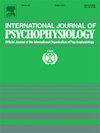Neural responses to global and local visual information processing provide neural signatures of ADHD symptoms
IF 2.5
3区 心理学
Q3 NEUROSCIENCES
引用次数: 0
Abstract
Individuals with ADHD are thought to exhibit a reduced “global bias” in perceptual processing. This bias, found in typically developed individuals, characterizes the tendency to prioritize global over local information processing. However, the relationship between specific ADHD symptoms and global or local processing remains unclear. This study addresses this gap by employing an ensemble perception task with a large sample (N = 465). EEG recordings allowed for the isolation of neural responses to individual and global stimuli using linear regression modeling. The adult ADHD self-report scale was used to assess ADHD symptoms. The results showed a significant association between ensemble perception and early responses to global stimuli. Furthermore, inattention symptoms were associated with early responses to global stimuli, suggesting a reduced global prioritization in individuals with higher inattention scores. Moreover, inattention symptom was associated with later responses to local stimuli, as shown by attenuated neural responses to local stimuli in individuals with more severe symptoms. These findings provide insights that ADHD includes deficits in both global and local processing, challenging earlier theories that focused solely on global processing impairments.
对整体和局部视觉信息处理的神经反应提供了ADHD症状的神经特征
ADHD患者被认为在知觉处理中表现出较低的“全局偏差”。这种偏见在典型的发达个体中发现,其特点是倾向于优先考虑全局而不是局部信息处理。然而,具体的ADHD症状与整体或局部加工之间的关系尚不清楚。本研究通过采用大样本(N = 465)的集成感知任务来解决这一差距。EEG记录允许使用线性回归模型隔离对个体和全局刺激的神经反应。采用成人ADHD自我报告量表评估ADHD症状。结果表明,整体感知与对全局刺激的早期反应之间存在显著关联。此外,注意力不集中症状与对全局刺激的早期反应有关,这表明注意力不集中得分较高的个体的全局优先级降低。此外,注意力不集中症状与后期对局部刺激的反应有关,如症状更严重的个体对局部刺激的神经反应减弱所示。这些发现提供了ADHD包括整体和局部加工缺陷的见解,挑战了早期只关注整体加工缺陷的理论。
本文章由计算机程序翻译,如有差异,请以英文原文为准。
求助全文
约1分钟内获得全文
求助全文
来源期刊
CiteScore
5.40
自引率
10.00%
发文量
177
审稿时长
3-8 weeks
期刊介绍:
The International Journal of Psychophysiology is the official journal of the International Organization of Psychophysiology, and provides a respected forum for the publication of high quality original contributions on all aspects of psychophysiology. The journal is interdisciplinary and aims to integrate the neurosciences and behavioral sciences. Empirical, theoretical, and review articles are encouraged in the following areas:
• Cerebral psychophysiology: including functional brain mapping and neuroimaging with Event-Related Potentials (ERPs), Positron Emission Tomography (PET), Functional Magnetic Resonance Imaging (fMRI) and Electroencephalographic studies.
• Autonomic functions: including bilateral electrodermal activity, pupillometry and blood volume changes.
• Cardiovascular Psychophysiology:including studies of blood pressure, cardiac functioning and respiration.
• Somatic psychophysiology: including muscle activity, eye movements and eye blinks.

 求助内容:
求助内容: 应助结果提醒方式:
应助结果提醒方式:


